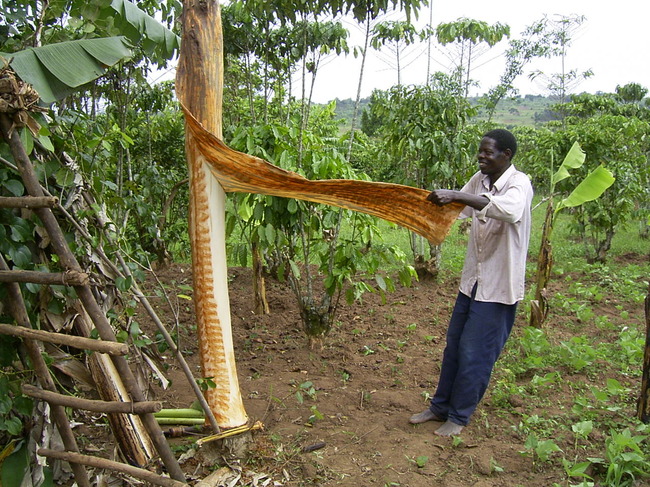Bark cloth is known to be one of the most adaptable materials. In southern Uganda, Baganda people practice the ancient craft. Bark cloth comes from the Mulberry/ fig family. This cloth is made by beating up soaked strips of inner bark and this goes for many hours and could be used for many other items.
This type of clothing is mainly designed for various ceremonies. The bark is being collected once in a year and till the next season the tree is left to regrow its bark again. The bark cloth got its name because of its rough surface. It is also used in making handbags, and other works of art.
Bark cloth is again into fashion for Buganda people. Other countries are also interested in learning the Eco friendly method.
Something more interesting about this cloth is that it can last for over 100years. This cloth was also used as a part of tradition in burying kings and queens.
The main drawback was the introduction of cotton but the traditional activities were mainly done with bark cloth wears.
Bark cloths were the symbol of protest against colonial administration during the independence. Bark cloth is also listed in the UNESCO as an “intangible cultural heritable “.
UNESCO says that making of bark cloth is one of the oldest methods that existed before weaving came into practice. In the 19th century, cotton came into existence and the manufacturing of bark cloth started to reduce. The new upgraded machines replaced many activities for people. After this fall, the people started to associate the cloth with the evil practices as it was used in funerals.
Does extraction of bark lead to deforestation?
No trees are cut down for the production of bark cloth. The bark is extracted from the tree and the layer is covered by the banana leaves to regain its growth. During 1990, Uganda faced a huge loss of 8 million acres of its land. Bark was in such demand that the buyers paid the cost for the tree to harvest.
Presently about Bark cloth
This cloth is being used in manufacturing of interior decor, apparels etc. The founder of kwetu Africa Art and Development Centre – Sanaa Gateja says that she is interested in bringing the cloth into mixed media collages, interior designs schemes and wearable art. There are many more other designers who want to explore more with sustainable clothes.
In the year 1999, a couple named Mary Barongo-Heintz and Oliver Heintz came up with the idea of trying something colorful. They started the dye, bleached or made flexible by combining with other substance’s. During this span of time, they decided to employ more women in craft.
Thus, the new designers are experimenting and discovering new possibilities. But still bark cloth remains the main traditional practice and its being continued.

